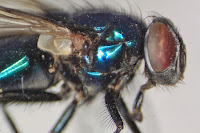With wet and dreary weather day by day, I thought it time to prepare for the Spring and Summer. I was really lucky over the weekend to get a place on an identification course for the families of Diptera - flies. They are seriously difficult and have few admirers as a result.
It was organised by the Dipterists Forum (
http://www.dipteristsforum.org.uk/) and the Oxford Natural History Museum,(
http://www.oum.ox.ac.uk/index.htm) and presented by Dr John and Barbara Ismay, two experts who run a consultancy but who are also world-renowned specialists in the Chloropidae family of flies (grass flies). Remarkably the course was free; John and Barbara got nothing for the 2 days and obviously substantial preparation time, because they are passionate about flies and what others to better appreciate an often neglected group of animals.
There were 12 participants on the course, young and old with quite a mix of backgrounds. My interest is in flower pollination, particularly orchids.
There are 7,200 species of fly in the UK, compared to perhaps 26 bumblebees, around 60 butterflies, and 500 birds. Flies are one of the insect orders, alongside Lepidotera (buttefrflies and moths) and so on. The species are grouped into over 100 families. The course concentrated on identifying to family - not easy and a microscope essential. Habitually I have taken pictures of flies and hope to identify them later from the photo. It will not work unless there are close ups of the head, (front and side) the side of the insect and the wing. Catching, killing and microscopic study is the only way.
Around 50 flies were prepared (beautifully) for study; using keys we identified around 18 representing the main groupings.
Zoë Simmons, the curator, led a tour of the insect collections held by the Museum, the second largest in the UK, and containing some historical items including tsetse flies collected by Livingstone. A large part of the collection dates back to 1849 when Rev. Frederick Hope donated his entomology collection to the museum There is a significant collection of flies made by Verrall and his nephew Collin, over 100 years ago.



An outstanding course and I cannot wait to find a few flies and fill the freezer with them.
 The highlights were two separate sightings of hares. They are seriously fast; the first raced off away from us disappearing at the top of a wheat field, within seconds - almost too quick to get binoculars on it. The second emerged from a coppice, did a semi-circle around us before disappearing into a dip. Brilliant to watch.
The highlights were two separate sightings of hares. They are seriously fast; the first raced off away from us disappearing at the top of a wheat field, within seconds - almost too quick to get binoculars on it. The second emerged from a coppice, did a semi-circle around us before disappearing into a dip. Brilliant to watch.














